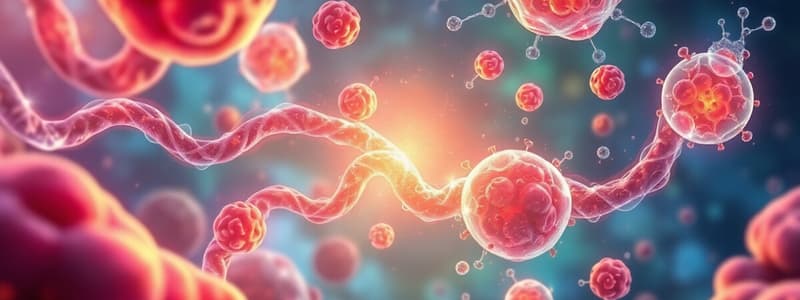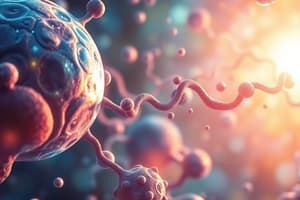Podcast
Questions and Answers
What is the primary function of negative feedback in physiological regulation?
What is the primary function of negative feedback in physiological regulation?
- To return a system to its normal range (correct)
- To amplify changes in physiological states
- To create permanent changes in the body
- To accelerate physiological changes
Which statement accurately describes positive feedback?
Which statement accurately describes positive feedback?
- It is the most common feedback mechanism in the body.
- It creates changes that are opposite to the initial stimulus.
- It enhances the change that initiated the response. (correct)
- It relies on slow mechanisms to alter physiological variables.
What kind of physiological changes does negative feedback primarily address?
What kind of physiological changes does negative feedback primarily address?
- Changes that need to be enhanced
- Consistent increases in physiological variables
- Deviations that should be corrected (correct)
- Unpredictable physiological events
Which is a characteristic of negative feedback compared to positive feedback?
Which is a characteristic of negative feedback compared to positive feedback?
What typically characterizes the action of positive feedback mechanisms?
What typically characterizes the action of positive feedback mechanisms?
What are coenzymes required for?
What are coenzymes required for?
What is the purpose of producing zymogens in the pancreas?
What is the purpose of producing zymogens in the pancreas?
What happens to the rate of enzymatic reactions when substrate concentration increases?
What happens to the rate of enzymatic reactions when substrate concentration increases?
When is an enzyme said to be saturated?
When is an enzyme said to be saturated?
Which of the following ions are required by enzymes for their active functions?
Which of the following ions are required by enzymes for their active functions?
What is the primary purpose of metabolism in living organisms?
What is the primary purpose of metabolism in living organisms?
Which of the following processes is an example of catabolism?
Which of the following processes is an example of catabolism?
What distinguishes enzymes from other proteins?
What distinguishes enzymes from other proteins?
Which type of metabolic process consumes energy?
Which type of metabolic process consumes energy?
What is a common characteristic of most enzymes?
What is a common characteristic of most enzymes?
What is the primary role of enzymes in chemical reactions?
What is the primary role of enzymes in chemical reactions?
What describes the active site of an enzyme in the Lock-and-Key model?
What describes the active site of an enzyme in the Lock-and-Key model?
How does temperature affect enzyme-catalyzed reactions?
How does temperature affect enzyme-catalyzed reactions?
What happens to enzymes at extreme pH levels?
What happens to enzymes at extreme pH levels?
Cofactors that assist enzymes are typically known as?
Cofactors that assist enzymes are typically known as?
What distinguishes negative feedback from positive feedback in physiological regulation?
What distinguishes negative feedback from positive feedback in physiological regulation?
Which characteristic is true of positive feedback mechanisms?
Which characteristic is true of positive feedback mechanisms?
In which scenario is negative feedback primarily utilized?
In which scenario is negative feedback primarily utilized?
How does negative feedback act upon a physiological change?
How does negative feedback act upon a physiological change?
Why can positive feedback mechanisms be potentially harmful in physiological processes?
Why can positive feedback mechanisms be potentially harmful in physiological processes?
What is the primary function of catabolism in cellular metabolism?
What is the primary function of catabolism in cellular metabolism?
What best describes the role of enzymes in chemical reactions?
What best describes the role of enzymes in chemical reactions?
Which process consumes energy to synthesize complex molecules?
Which process consumes energy to synthesize complex molecules?
What characteristic is common to most enzymes?
What characteristic is common to most enzymes?
Which of the following statements accurately describes anabolism?
Which of the following statements accurately describes anabolism?
What is the primary role of coenzymes in enzymatic reactions?
What is the primary role of coenzymes in enzymatic reactions?
What protects pancreatic cells from self-digestion?
What protects pancreatic cells from self-digestion?
What occurs when enzyme concentration remains constant but substrate concentration increases?
What occurs when enzyme concentration remains constant but substrate concentration increases?
Which of the following statements about enzyme saturation is correct?
Which of the following statements about enzyme saturation is correct?
How does homeostasis relate to enzyme function?
How does homeostasis relate to enzyme function?
What is the role of enzymes in relation to activation energy during a chemical reaction?
What is the role of enzymes in relation to activation energy during a chemical reaction?
What happens to an enzyme when subjected to extreme temperature increases beyond its optimal range?
What happens to an enzyme when subjected to extreme temperature increases beyond its optimal range?
How does pH affect enzymatic reactions?
How does pH affect enzymatic reactions?
What characterizes the active site of an enzyme in the Lock-and-Key model?
What characterizes the active site of an enzyme in the Lock-and-Key model?
Which of the following factors does NOT affect the rate of enzymatic reactions?
Which of the following factors does NOT affect the rate of enzymatic reactions?
What is the primary outcome of a negative feedback mechanism in physiological regulation?
What is the primary outcome of a negative feedback mechanism in physiological regulation?
Which statement best captures the essence of positive feedback?
Which statement best captures the essence of positive feedback?
How does negative feedback specifically affect the regulation of blood glucose levels?
How does negative feedback specifically affect the regulation of blood glucose levels?
Which of the following is an example of a scenario where positive feedback is typically utilized?
Which of the following is an example of a scenario where positive feedback is typically utilized?
What distinguishes negative feedback from positive feedback in physiological systems?
What distinguishes negative feedback from positive feedback in physiological systems?
What is the primary function of coenzymes in enzymatic reactions?
What is the primary function of coenzymes in enzymatic reactions?
What is a significant advantage of producing zymogens in the pancreas?
What is a significant advantage of producing zymogens in the pancreas?
When the rate of enzymatic reactions has reached its maximum rate, what condition is met?
When the rate of enzymatic reactions has reached its maximum rate, what condition is met?
How does increasing substrate concentration impact an enzymatic reaction when enzyme concentration is held constant?
How does increasing substrate concentration impact an enzymatic reaction when enzyme concentration is held constant?
Which of the following describes homeostasis in the context of enzymatic functions?
Which of the following describes homeostasis in the context of enzymatic functions?
Which process is an example of an anabolic reaction?
Which process is an example of an anabolic reaction?
What is the primary outcome of catabolic reactions in cellular metabolism?
What is the primary outcome of catabolic reactions in cellular metabolism?
Which characteristic of enzymes describes their role in chemical reactions?
Which characteristic of enzymes describes their role in chemical reactions?
Which of the following statements about metabolic processes is true?
Which of the following statements about metabolic processes is true?
What role do enzymes play in relation to activation energy?
What role do enzymes play in relation to activation energy?
What effect does an increase in temperature have on enzyme activity until the maximum rate is reached?
What effect does an increase in temperature have on enzyme activity until the maximum rate is reached?
What is the consequence of an enzyme operating outside its optimal pH range?
What is the consequence of an enzyme operating outside its optimal pH range?
How do enzymes contribute to the reaction between substrates?
How do enzymes contribute to the reaction between substrates?
Which factor is least likely to affect the rate of enzymatic reactions?
Which factor is least likely to affect the rate of enzymatic reactions?
What characteristics are associated with the Lock-and-Key model of enzyme action?
What characteristics are associated with the Lock-and-Key model of enzyme action?
Flashcards are hidden until you start studying
Study Notes
Metabolism
- A set of chemical reactions within living organisms that sustain life
- Enables growth, reproduction, maintenance, and environmental response
- Divided into two categories: catabolism and anabolism
Catabolism
- Breaks down large molecules into smaller units, releasing energy
- Example: glycolysis, the breakdown of glucose for energy
Anabolism
- Synthesizes complex molecules from smaller units, consuming energy
- Example: the construction of amino acids into proteins
- Example: glycogenesis, the conversion of glucose into glycogen
Enzymes
- Biological catalysts that speed up chemical reactions without being altered
- Made of proteins, their complex structure enables catalytic activity
- Many enzyme names end in "-ase" (e.g., maltase, lactase)
Activation Energy
- The minimum energy required for reactants to initiate a reaction
- Enzymes lower activation energy, allowing more reactants to participate
Lock-and-Key Model
- Enzyme's active site binds specifically to the substrate, enabling the reaction
Factors Affecting Enzyme Activity
- Temperature: most enzymes have an optimal temperature range, outside of which activity decreases due to denaturation
- pH: enzymes function best within a narrow pH range, extreme pH denatures enzymes
- Enzyme Activation: some enzymes are initially inactive and require activation within cells
- Substrate Concentration: increasing substrate concentration increases the rate of reaction until saturation point is reached
Homeostasis
- The body's ability to maintain a stable internal environment, despite external fluctuations
- Relies on feedback mechanisms: negative and positive feedback
Negative Feedback
- The most common type
- Counteracts changes in a physiological variable, restoring balance
- Example: regulating blood glucose levels, body temperature
Positive Feedback
- Amplifies the initial change, accelerating the process
- Example: blood clotting cascade, childbirth
Metabolism
- A set of chemical reactions occurring within the cells of a living organism to sustain life
- Catabolism breaks down large molecules into smaller units, releasing energy (e.g., glycolysis)
- Anabolism synthesizes complex molecules, consuming energy (e.g., creating proteins from amino acids, glycogenesis)
Enzymes
- Biological catalysts that speed up chemical reactions without changing the nature of the reaction
- Remain unchanged at the end of the reaction
- Primarily made of proteins
- Have names ending in "-ase" (e.g., maltase, lactase)
Activation Energy
- The energy required for reactants to begin a reaction
- Enzymes lower the activation energy, increasing reaction rate
- More reactants can participate in the reaction with the help of enzymes
Mechanism of Enzyme Action: Lock-and-Key Model
- Enzymes have a specific active site that binds to the substrate (the molecule the enzyme acts upon)
- This binding allows the enzyme to catalyze the reaction
Factors Affecting Enzyme Rate
- Temperature: Most enzymes are inactive at low temperatures but increase activity with higher temperatures up to a specific point
- pH: Each enzyme has an optimal pH for maximum activity
- Enzyme Activation: Some enzymes are produced in an inactive form (zymogens) and later activated (e.g., digestive enzymes in the pancreas)
- Substrate Concentration: Increased substrate concentration increases reaction rate until it reaches a maximum rate when the enzyme is saturated
Homeostasis
- The ability of an organism to maintain stable internal conditions despite external changes (e.g., blood glucose levels, body temperature)
- Often regulated by negative feedback mechanisms
Negative Feedback
- The most common feedback mechanism
- The body's response counteracts the change that initiated it
- Helps to restore balance to the system
Positive Feedback
- The body's response amplifies the initial change
- Can cause rapid changes in a physiological variable
- Often used for rapid processes, like childbirth
Metabolism
- A set of chemical reactions that happen in living cells to sustain life
- Allows an organism to grow, reproduce, maintain its structure, and respond to its environment
- Catabolism breaks down large molecules into smaller units & releases energy
- Example: Glycolysis breaks down glucose for energy
- Anabolism synthesizes complex molecules and consumes energy
- Examples:
- Amino acids combine to form proteins
- Glycogenesis: Glucose is converted into glycogen
- Examples:
Enzymes
- Biological catalysts that increase the rate of a chemical reaction without being changed themselves
- Are proteins with complex structures for their catalytic actions
- Mostly named with the suffix "-ase" (e.g. maltase, lactase)
- Activation energy is the amount of energy required for a reaction to occur
- Enzymes lower the activation energy, making reactions proceed more easily
- Lock-and-Key model describes how enzymes bind to substrates
- Enzymes have an active site where the substrate binds specifically, and the reaction is catalyzed
Factors Affecting Enzyme Activity
- Temperature affects enzyme activity
- Activity increases with increasing temperatures until an optimum temperature is reached
- Further increases in temperature lead to denaturation, where the enzyme loses its active conformation and becomes inactive
- pH affects enzyme activity
- Each enzyme has a pH optimum where it functions best
- Extreme pH values can lead to denaturation
- The pH optimum of an enzyme usually reflects the pH of the body fluid where it is found
- Cofactors are usually metal ions (e.g. Ca2+, Mg2+, Cu2+, Zn2+) required for enzyme function
- Coenzymes are small organic molecules required for enzyme function
- Usually derived from water-soluble vitamins
- Enzyme activation involves producing enzymes in an inactive form (zymogens) that are activated later within the cell
- Example: Digestive enzymes in the pancreas are produced as zymogens and become active in the intestine
- Substrate concentration affects enzyme activity
- As substrate concentration increases, the rate of the reaction increases until a maximum rate is reached
- At this point, the enzyme is said to be saturated
- As substrate concentration increases, the rate of the reaction increases until a maximum rate is reached
- Reversible reactions can be influenced by enzyme concentration:
- Increasing enzyme concentration also increases the rate of the reaction
Homeostasis
- The body's ability to maintain a stable internal environment despite external changes
- Examples: Maintaining blood glucose levels and body temperature
- Feedback mechanisms regulate physiological events
- Negative feedback is more common and involves a response that opposes the initial change
- Positive feedback enhances the initial change and is less common
Important Words
- Metabolism: All chemical reactions in a living organism
- Catabolism: Breakdown of molecules
- Anabolism: Synthesis of molecules
- Enzyme: Biological catalyst
- Specific: Acting on a particular molecule
- Denatured: Loss of active conformation
- Saturated: All active sites on an enzyme are occupied
- Positive feedback: Amplifies initial change
- Negative feedback: Opposes initial change
Studying That Suits You
Use AI to generate personalized quizzes and flashcards to suit your learning preferences.



